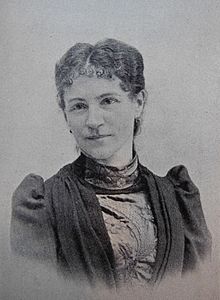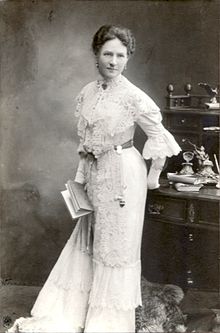Elise Beck
Elise Beck , b. Hartmann, (born October 25, 1855 in Ponholz , † November 24, 1912 in Munich ) was a German writer, local poet from Lower Bavaria and reciter .
Life
Elise Hartmann came as one of five daughters of the brewery and estate owner Alois Hartmann and his wife Elisabeth, née. Lecker (born September 3, 1833; † October 22, 1904), in the Alte Post in Ponholz near Regensburg (today the Maxhütte-Haidhof municipality ). Her father died on January 14, 1858 at the age of only 27 years of "emaciation". After remarrying with the privateer Joseph Kölz (* February 20, 1825 - May 2, 1878), the family had to leave the estate and moved to Stadtamhof. Elise attended the monastery school and then lived with relatives in Lower Bavaria, where she became familiar with the dialect of the "Gäubauer". Extensive trips followed, including to Philadelphia . Back in Germany, she married the editor, writer and reciter Julius Beck (1852–1920) in Munich in 1885 and lived with him and her son Julius Adolph, born in 1888, in Munich until she died in 1912 at the age of 57. Even a French publication reported her death. Her grave is in Munich's Ostfriedhof , field 81.
Elise Beck wrote pamphlets for young people, festival and Christmas games and appeared for the first time in 1895 with her volume of poetry Aus der Hoamat as a dialect poet in the succession of Kobell and Stieler . The composer Vinzenz Goller set two of her poems to music. She cultivated friendly contacts with other Bavarian dialect poets such as Maximilian Schmidt , Aloys Dreyer , Fritz Druckseis , Wilhelm Dusch , Max Hofmann and August Ganther and Heinrich Hansjakob from the Black Forest. Her lecture evenings enjoyed great popularity, as numerous reviews of this kind show: "For example, Ms. Elise Beck gained the most enthusiastic applause by reading some of her humorous, characteristic Lower Bavarian poems." “Ms. Elise Beck found these days in Berlin with her Lower Bavarian dialect Poetry an almost enthusiastic reception. " Gustav Adolf Müller even describes her as" the first, greatest poet in Lower Bavaria - the researchers of Bavarian folklore and literature can no longer ignore her. It does not give the 'punchlines' you are looking for, it gives the whole people's soul. ”The obituary of her Lower Bavarian writer colleague Aloys Dreyer judges more critically:“ Like almost most of the more recent dialect poets, the author of the hits at the end of the poem is the main and the milieu description is a minor matter. That is why there are many well-versed anecdotes translated into dialect in both collections. The comfortable humor that prevails in it belies an often palpable weakness, the lack of natural truth. ”A reproach that falls short in that Beck's texts were those of a humorous lecturer who made their successes in direct contact with hers Audiences celebrated in halls like the Munich Colosseum or the Leopold.
Works
- “ At the right time. A Christmas story ”in: Münchener Kindl. A literary almanac , 1890, pp. 52-57
- From the Hoamat. Lower Bavarian poems. Fiedler, Leipzig 1895.
- Farmer's blood. Lower Bavarian poems. Finsterlin, Munich 1900.
- In noble competition. Festival. 1900.
- At the right moment. Christmas game. 1901.
- "The Lower Bavarian in sayings and idioms"
literature
- Beck, Elise in: Franz Brümmer : Lexicon of German poets and prose writers from the beginning of the 19th century to the present . Volume 1. Brockhaus, Leipzig 1913, p. 157.
- Beck, Elise in: Elisabeth Friedrichs: The German-speaking women writers of the 18th and 19th centuries. A lexicon . Metzler, Stuttgart 1981, ISBN 3-476-00456-2 , (Repertories on the history of German literature 9), p. 18.
- Adolf Dyroff (not identified as the author), "Eine Bavarian Dialect Poet" in Deutscher Hausschatz , October 1900 - October 1901, pp. 29–30.
- Anton Mansch, ed., Geistige Welten. Gallery of contemporaries in the field of arts and sciences , Berlin 1905
- Gustav Adolf Müller, review of Bauernbluat in: Das Magazin. Monthly magazine for literature, art and culture , 1909, p. 159
- Beck, Elise . In: Sophie Pataky (Hrsg.): Lexicon of German women of the pen . Volume 1. Verlag Carl Pataky, Berlin 1898, p. 45 ( digitized version ).
- Peter Steger, “Elise Beck. From the 'Hoamat' to the world “(On the 100th anniversary of Elise Beck's death), in Mittelbayerische Zeitung on September 22, 2012
Web links
- Elise Beck in the Bavarian literature portal (project of the Bavarian State Library )
Individual evidence
- ^ Regensburger Zeitung of January 21, 1858, p. 84
- ↑ Death register of the parish Leonberg
- ^ Aloys Dreyer in: Anton Bettelheim, Biographisches Jahrbuch und deutscher Nekrolog, Volume 17, 1912, p. 136
- ↑ Cf. Société bibliographique (ed.): Polybiblion, Revue bibliographique universelle . Volume 124. Aux bureaux de la revue, 1912: "Mme Elise Beck, femme de lettres allemande, morte à Munich, à la fin de novembre, à 57 years, laquelle laisse des poésies écrites dans la langue popular."
- ↑ Vinzenz Goller, Singt's mit !: 25 songs in the Bavarian folk tone for male singing , op. 59, Regensburg 1909.
- ^ Munich Latest News , February 2, 1893
- ^ Munich Latest News , February 1900
- ^ The magazine: monthly for literature, art and culture , 1909. p. 159
- ^ Aloys Dreyer in: Anton Bettelheim, Biographisches Jahrbuch und deutscher Nekrolog, Volume 17, 1912, p. 137
- ↑ Kil's Colosseum on Müllerstrasse
- ↑ Traditional restaurant on Leopoldstrasse, where Wedekind and Liesl Karlstadt also performed.
- ↑ No copy provable
- ↑ No copy provable
- ↑ Das Bayerland , Volume 13, 1902, pp. 429–31, 441–43, 467–68.
| personal data | |
|---|---|
| SURNAME | Beck, Elise |
| ALTERNATIVE NAMES | Hartmann, Elise |
| BRIEF DESCRIPTION | German writer |
| DATE OF BIRTH | October 25, 1855 |
| PLACE OF BIRTH | Ponholz , today at Maxhütte-Haidhof |
| DATE OF DEATH | November 24, 1912 |
| Place of death | Munich |




